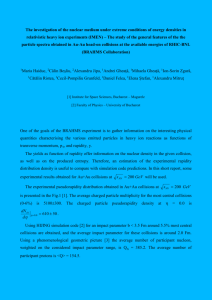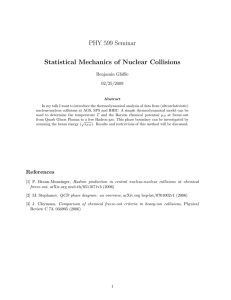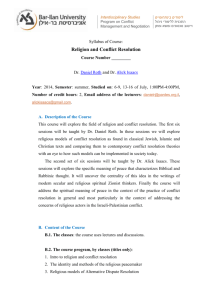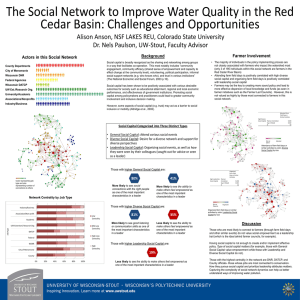Kinematic bias on centrality selection of jet events in pPb
advertisement
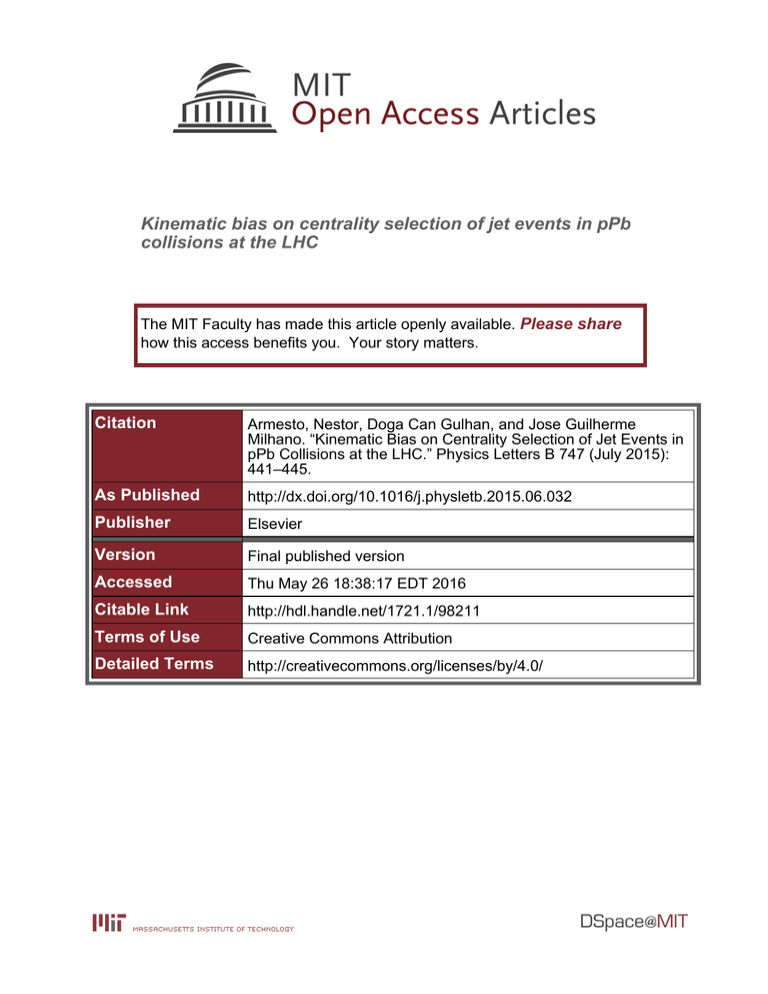
Kinematic bias on centrality selection of jet events in pPb collisions at the LHC The MIT Faculty has made this article openly available. Please share how this access benefits you. Your story matters. Citation Armesto, Nestor, Doga Can Gulhan, and Jose Guilherme Milhano. “Kinematic Bias on Centrality Selection of Jet Events in pPb Collisions at the LHC.” Physics Letters B 747 (July 2015): 441–445. As Published http://dx.doi.org/10.1016/j.physletb.2015.06.032 Publisher Elsevier Version Final published version Accessed Thu May 26 18:38:17 EDT 2016 Citable Link http://hdl.handle.net/1721.1/98211 Terms of Use Creative Commons Attribution Detailed Terms http://creativecommons.org/licenses/by/4.0/ Physics Letters B 747 (2015) 441–445 Contents lists available at ScienceDirect Physics Letters B www.elsevier.com/locate/physletb Kinematic bias on centrality selection of jet events in pPb collisions at the LHC Néstor Armesto a , Doğa Can Gülhan b,∗ , José Guilherme Milhano c,d a Departamento de Física de Partículas and IGFAE, Universidade de Santiago de Compostela, E-15706 Santiago de Compostela, Galicia, Spain Laboratory for Nuclear Science and Department of Physics, Massachusetts Institute of Technology (MIT), Cambridge, MA 02139, USA CENTRA, Instituto Superior Técnico, Universidade de Lisboa, Av. Rovisco Pais, P-1049-001 Lisboa, Portugal d Physics Department, Theory Unit, CERN, CH-1211 Genève 23, Switzerland b c a r t i c l e i n f o Article history: Received 11 February 2015 Received in revised form 5 June 2015 Accepted 11 June 2015 Available online 16 June 2015 Editor: J.-P. Blaizot a b s t r a c t Centrality selection has been observed to have a large effect on jet observables in pPb collisions at the Large Hadron Collider, stronger than that predicted by the nuclear modification of parton densities. We study to which extent simple considerations of energy–momentum conservation which link the hard process with the underlying event that provides the centrality estimator, affect jets observables in such collisions. We develop a simplistic approach that considers first the production of jets in a pp collision as described by PYTHIA. From each pp collision, the value of the energy of the parton from the proton participating in the hard scattering is extracted. Then, the underlying event is generated simulating a pPb collision through HIJING, but with the energy of the proton decreased according to the value extracted in the previous step, and both collisions are added. This model is able to capture the bulk of the centrality effect for central to semicentral collisions, for the two available sets of data: dijets from the CMS Collaboration and single jets from the ATLAS Collaboration. As expected, the model fails for peripheral collisions where very few nucleons from Pb participate. © 2015 The Authors. Published by Elsevier B.V. This is an open access article under the CC BY license (http://creativecommons.org/licenses/by/4.0/). Funded by SCOAP3 . 1. Introduction In nuclear collisions, the classification of events according to some measurement of their activity – energy, multiplicity – in some region of phase space, generically called centrality selection, is extensively done. Such classification, if it turns out to be well defined, should allow the study of different observables for the same kind of events. For example, one could naively expect that the same energy density or temperature is achieved in highenergy heavy-ion collisions of the same centrality, and one would study jet production, photon spectra, etc. for these events, allowing a characterisation of the strongly interacting matter produced in such collisions. Besides, it could provide a link, albeit in a modeldependent way, to theoretically defined quantities as the impact parameter of the collision. The key issue to be settled is whether a centrality class defined by different centrality criteria for events with a given characteristics e.g. containing jets with a given transverse energy or * Corresponding author. E-mail addresses: nestor.armesto@usc.es (N. Armesto), dgulhan@mit.edu (D.C. Gülhan), guilherme.milhano@tecnico.ulisboa.pt (J.G. Milhano). quarkonium, corresponds to the same subset of events. Specifically: whether the centrality selection (and its link to some theoretical quantity as the impact parameter) depends (i) on the centrality criterium and (ii) on the characteristics under consideration i.e. whether there is a coupling between the characteristics of the events that we are considering e.g. the presence of jets, and the centrality criterium. While in non-peripheral collisions between heavy ions, the classification of centrality classes appears to be quite robust, in proton-lead collisions at the Large Hadron Collider (LHC) the situation is more problematic.1 Specifically, for dijets [3] and single jets [4], the minimum bias results are well reproduced by standard pQCD with nuclear modification of parton densities, while the centrality-selected results show a strong dependence on centrality that cannot be accommodated by the existing ideas on the impact parameter dependence of nuclear parton densities [5–7]. There is an ongoing discussion on the definition of centrality in such asymmetric systems [8,9]. 1 The problem also exists in dAu collisions at the Relativistic Heavy Ion Collider (RHIC), see e.g. [1,2]. http://dx.doi.org/10.1016/j.physletb.2015.06.032 0370-2693/© 2015 The Authors. Published by Elsevier B.V. This is an open access article under the CC BY license (http://creativecommons.org/licenses/by/4.0/). Funded by SCOAP3 . 442 N. Armesto et al. / Physics Letters B 747 (2015) 441–445 The origin of the difference of the situation between heavyion and proton-nucleus collisions may have different origins. For example, the larger fluctuations in the number of participating nucleus or the more stringent energy–momentum conservation demands, in the latter than in the former. Indeed, this problem can be traced back to our lack of understanding of the detailed microscopic dynamics underlying soft particle production in hadronic and nuclear collisions, and its coupling to hard subprocesses. Several works have recently appeared that deal with this point [10–13]. In this work we address the role of some kinematic constraints – those on the proton – that the demand of a hard subprocess imposes on the soft particle production that determines the centrality criterium, using a simplistic framework. We focus on the CMS dijet [3] and ATLAS single [4], results in pPb collisions at 5.02 TeV/nucleon. We find that even this simplistic implementation of kinematic constraints has a strong effect in the direction found in the experimental data, while it fails where the implementation is evidently deficient. The manuscript is organised as follows: in Section 2, we describe the model that implements energy–momentum conservation constraints on the proton. Then, in Sections 3 and 4, we employ the model to analyse the extent to which CMS results on dijets and ATLAS results on single jets, respectively, can be understood as resulting from kinematic considerations. Finally, in Section 5 we present our conclusions. 2. Description of the model The model that we employ uses PYTHIA [14] for the hard scattering and HIJING [15,16] for the underlying event. We generate a sample of events (105 for dijets and 2 · 106 for single jet spectra), each one through the following procedure: 1. We generate a pp event in PYTHIA (for a proton beam of √ E p = 4 TeV and a Pb beam of E Pb = 1.58 TeV/nucleon, s N N = 5.02 TeV) with the required characteristics: jets or dijets with the experimental kinematic cuts, and extract the momentum fraction x p of the hard parton from the proton participating in the 2 → 2 hard subprocess. 2. We generate a minimum bias pPb event in HIJING, for a proton beam of (1 − x P ) E p and a Pb beam of E Pb i.e. we re√ duce the proton energy for the underlying event, so s N N = 2 (1 − x p ) E p E Pb . 3. We shift both events (that are generated in their respective center of mass) to a common frame (the LHC laboratory frame). 4. The HIJING event, generated as minimum bias, is reweighted through its impact parameter to fulfil scaling in the number of collisions N coll expected for hard events. 5. The PYTHIA and HIJING events are superimposed, resulting in a full pPb event with the weight given in the previous step. Note that the momentum fraction xPb of the parton from the Pb participating in the 2 → 2 hard subprocess is unchanged. This is clearly a deficiency of the model, which should be expected to fail for small N coll (when the number of participating nucleons from the Pb is small) and for large xPb (for the Pb-going side in pseudorapidity). Also note that in our simple model, energy–momentum conservation is imposed sequentially and not globally as it should be properly done. Besides, due to the intrinsic link of soft and hard physics in PYTHIA through colour strings between partons coming from the hard sub-collision and those from either other hard sub-collisions or from the underlying event, there is no unique, Fig. 1. Average dijet pseudorapidity (ηdijet = (η1 + η2 )/2) as a function of the total transverse energy deposition in the pseudorapidity range of 4 < |η| < 5 for PYTHIA+HIJING events matched according to x p value (black squares) overlaid with data measured by CMS [3] (red circles). well-defined way for separating what should be subtracted from PYTHIA in order to avoid eventual double counting. The desirable thing would be the use of a model that correctly describes soft and hard observables simultaneously but, unfortunately, we are not aware of such an updated model. But we find it noticeable that such a simple model as the one we propose, which can only be expected to capture the bulk features of some of the physics behind the experimentally observed phenomena, is actually able to reproduce the trend of the data. Actually one of the aims of the paper is to trigger efforts in the direction of elaborating simulators that properly link soft and hard aspects of a pA collision. 3. CMS dijet results In this section we analyse the dijet measurements by CMS [3]. We generate hard events in PYTHIA with jets reconstructed within |η| < 3 using the anti-k T sequential recombination algorithm [17, 18] with a distance parameter of 0.3, considering events required to have a dijet with a leading jet p T ,1 > 120 GeV/c, a subleading jet p T ,2 > 30 GeV/c, and an azimuthal distance φ1,2 > 2π /3. Then, for the full PYTHIA+HIJING generated event, the transverse energy in the region 4 < |η| < 5 is rescaled, to match the one in CMS, by a factor to account for detector resolution effects that are not corrected by CMS. It is this energy that is then used to classify events in centrality. In Fig. 1 we show the comparison of our results on the average dijet pseudorapidity (ηdijet = (η1 + η2 )/2) as a function of the total transverse energy deposition in the pseudorapidity range of 4 < |η| < 5, compared with data measured by CMS [3]. The agreement is very good except for the lowest transverse energies, corresponding to peripheral collisions where the model is not expected to work as discussed in the previous section. In Fig. 2 we show the ratio of the dijet pseudorapidity distribution for events in a given centrality class over the minimum bias distribution, compared to the CMS data. Again, a good overall agreement is found. CMS [3] also provided data on the average dijet pseudorapidp ity for a fixed energy in the p-going-direction, E T for 4 < η < 5, as a function of the energy in the Pb-going-direction, E TPb for −5 < η < −4. In Fig. 3 we show the comparison of the CMS data with our PYTHIA+HIJING results. Once more, the model captures the trend of data except for the lowest activity data where N. Armesto et al. / Physics Letters B 747 (2015) 441–445 443 [4<|η|<5] Fig. 2. Ratios of dijet pseudorapidity (ηdijet = (η1 + η2 )/2) distributions with a selection on total forward energy deposition (ET ) to the dijet pseudorapidity distribution without any requirement on event activity are shown. The calculation in PYTHIA+HIJING is shown by black squares and CMS data points [3] are shown by red circles. Fig. 3. (Left) CMS data [3], (Right) PYTHIA+HIJING with x p matching. Coloured markers show average dijet pseudorapidity (ηdijet = (η1 + η2 )/2) as a function of transverse p energy deposition in the Pb-going-direction, E TPb , for bins of the transverse energy deposition in the p-going-direction, E T . The choice of pseudorapidity intervals for E TPb p and E T are −5 < η < −4 and 4 < η < 5 respectively. The black line shows average dijet pseudorapidity as a function of E TPb when the requirements on transverse energy in proton going direction are removed. (For interpretation of the colours in this figure, the reader is referred to the web version of this article.) only one or two nucleons from the Pb nucleus contribute and the model – that corrects for energy only on the proton side – is clearly deficient due to the over simplicity treatment of the Pb. 4. ATLAS jet results In this section we analyse the single-jet measurements by ATLAS [4]. We generate hard events in PYTHIA with jets reconstructed using the anti-k T sequential recombination algorithm [17, 18] with a distance parameter of 0.4, in the region |ηjet − ηCM | < 3. The centrality criterium is, in this case, the total transverse energy in Pb-going-direction within the pseudorapidity range of −4.9 < η < −3.2, thus less sensitive to energy constraints on the proton. Let us note that we use, for the different centrality classes, the number of collisions N coll provided by ATLAS and not the one ex- tracted from HIJING.2 In Fig. 4 we show the results of the model for the nuclear modification factor R pPb of jets as a function of their transverse momentum, for different centrality classes, integrated over the whole pseudorapidity region |ηjet − ηCM | < 3. The effect of the centrality selection becomes evident. In Figs. 5, 6 and 7 we show a comparison of the results of the model with ATLAS data [4] for the nuclear modification factor R pPb of jets as a function of their transverse momentum in different pseudorapidity bins, for central, semicentral and peripheral collisions respectively. A good agreement with data is found for central collisions that deteriorates with decreasing centrality, until 2 They are (11.94,9.86,8.38,6.934,4.82,2.29) for HIJING and (14.57,12.07,10.37,8.94, 6.44,2.98) in the ATLAS paper [4], for the 0–10%, 10–20%, 20–30%, 30–40%, 40–60% and 60–90% centrality classes respectively. 444 N. Armesto et al. / Physics Letters B 747 (2015) 441–445 Fig. 4. R pPb calculation in PYTHIA+HIJING with x p matching are shown for 0–10%, 10–20%, 20–30%, 30–40%, 40–60% and 60–90% centrality classes. The centrality classes are determined according to total transverse energy in Pb-going-direction within the pseudorapidity range of −4.9 < η < −3.2. Fig. 5. R pPb calculation in PYTHIA+HIJING with x p matching (grey bands) and the measured values by ATLAS ([4], red circles) are shown for the 0–10% centrality class in bins of pseudorapidity in the center-of-mass frame. The centrality classes are determined according to total transverse energy in Pb-going-direction within the pseudorapidity range of −4.9 < η < −3.2. Fig. 6. R pPb calculation in PYTHIA+HIJING with x p matching (grey bands) and the measured values by ATLAS ([4], blue circles) are shown for the 20–30% centrality class in bins of pseudorapidity in the center-of-mass frame. The centrality classes are determined according to total transverse energy in Pb-going-direction within the pseudorapidity range of −4.9 < η < −3.2. N. Armesto et al. / Physics Letters B 747 (2015) 441–445 445 Fig. 7. R pPb calculation in PYTHIA+HIJING with x p matching (grey bands) and the measured values by ATLAS ([4], black circles) are shown for the 60–90% centrality class in bins of pseudorapidity in the center-of-mass frame. The centrality classes are determined according to total transverse energy in Pb-going-direction within the pseudorapidity range of −4.9 < η < −3.2. the model fails for peripheral collisions as expected from previous discussions. 5. Conclusions In this work, we have analysed the effect of centrality selection on events characterised by a hard observable, in pPb collisions at the LHC. We have focused on the influence of the interplay given by simple considerations of energy–momentum conservation, between the hard process that is the observable of interest – jet production – and the underlying event that provides the centrality estimator. We have developed a simplistic model that considers first the production of jets in a pp collision as described by PYTHIA. From each pp collision, the value of the energy of the parton from the proton participating in the hard scattering is extracted. Then, the underlying event is generated simulating a pPb collision through HIJING, but with the energy of the proton decreased according to the value extracted in the previous step. The full event consists in the superposition of the hard and underlying ones. In this way the energy constraints on the proton are taken into account, while those on the Pb nucleus are not considered. The model is thus expected to fail for peripheral collisions where very few nucleons from Pb participate. Note that our model is not a dynamical one, see other explanations in [10–13], our only aim being the study of how important this kind of biases may become on existing experimental data. We have considered two sets of data: dijets from CMS [3] and single jets from ATLAS [4] and find that the model is able to capture the bulk of the centrality effect for central to semicentral collisions, while it fails – as it should – for peripheral collisions. We conclude that this simple bias due to energy–momentum conservation must be considered before any extraction of other eventual centrality dependencies as those of nuclear parton densities. The obvious extension of this work is to include the energy– momentum constraints on the nucleus side, which we plan to address. In any case, we find that data as those discussed in this manuscript, offer most valuable information for the development of models for high-energy hadronic and nuclear collisions, as they link perturbative computable quantities as jets with those coming from the underlying event that can only be addressed through modelling soft particle production. Acknowledgements We thank Brian Cole, Yen-Jie Lee, Gavin Salam and Gunther Roland for useful discussions, and Anna Zsigmond for providing a running version of HIJING. N.A. thanks the Theory Unit at CERN for hospitality and support during stays when part of this work was developed. The work of N.A. is supported by the European Research Council grant HotLHC ERC-2011-StG-279579; by Ministerio de Ciencia e Innovación of Spain under projects FPA2011-22776; by Xunta de Galicia (Consellería de Educación and Consellería de Innovación e Industria – Programa Incite); and by the Spanish Consolider-Ingenio 2010 Programme CPAN and by European Funds for Regional Development (FEDER). The work of D.C.G. is supported by the U.S. Department of Energy under cooperative research agreement DE-SC0011088. The work of J.M.G. is supported by Fundação para a Ciência e a Tecnologia of Portugal under project CERN/FP/123596/2011 and contract ’Investigador FCT – Development Grant’. References [1] A. Adare, et al., PHENIX Collaboration, Phys. Rev. C 88 (2013) 024906, arXiv:1304.3410 [nucl-ex]. [2] L. Adamczyk, et al., STAR Collaboration, arXiv:1412.8437 [nucl-ex]. [3] S. Chatrchyan, et al., CMS Collaboration, Eur. Phys. J. C 74 (2014) 2951, arXiv:1401.4433 [nucl-ex]. [4] G. Aad, et al., ATLAS Collaboration, arXiv:1412.4092 [hep-ex]. [5] N. Armesto, A. Capella, A.B. Kaidalov, J. Lopez-Albacete, C.A. Salgado, Eur. Phys. J. C 29 (2003) 531, arXiv:hep-ph/0304119. [6] L. Frankfurt, V. Guzey, M. Strikman, Phys. Rep. 512 (2012) 255, arXiv:1106.2091 [hep-ph]. [7] I. Helenius, K.J. Eskola, H. Honkanen, C.A. Salgado, J. High Energy Phys. 1207 (2012) 073, arXiv:1205.5359 [hep-ph]. [8] A. Adare, et al., PHENIX Collaboration, Phys. Rev. C 90 (2014) 034902, arXiv:1310.4793 [nucl-ex]. [9] J. Adam, et al., ALICE Collaboration, arXiv:1412.6828 [nucl-ex]. [10] G. Martinez-Garcia, arXiv:1408.3108 [hep-ph]. [11] A. Bzdak, V. Skokov, S. Bathe, arXiv:1408.3156 [hep-ph]. [12] M. Alvioli, B. Cole, L. Frankfurt, M. Strikman, arXiv:1409.7381 [hep-ph]. [13] D.V. Perepelitsa, P.A. Steinberg, arXiv:1412.0976 [nucl-ex]. [14] T. Sjostrand, S. Mrenna, P.Z. Skands, J. High Energy Phys. 0605 (2006) 026, arXiv:hep-ph/0603175. [15] X.N. Wang, M. Gyulassy, Phys. Rev. D 44 (1991) 3501. [16] M. Gyulassy, X.N. Wang, Comput. Phys. Commun. 83 (1994) 307, arXiv:nucl-th/ 9502021. [17] M. Cacciari, G.P. Salam, G. Soyez, J. High Energy Phys. 0804 (2008) 063, arXiv:0802.1189 [hep-ph]. [18] M. Cacciari, G.P. Salam, G. Soyez, Eur. Phys. J. C 72 (2012) 1896, arXiv:1111.6097 [hep-ph].
